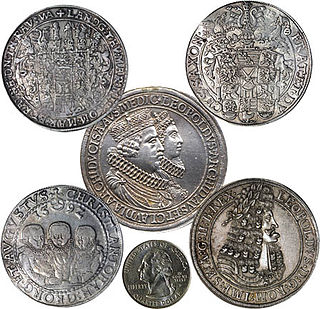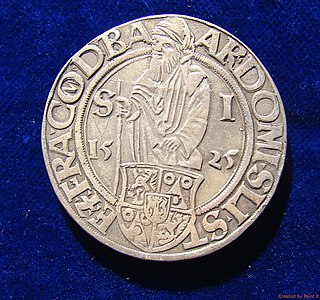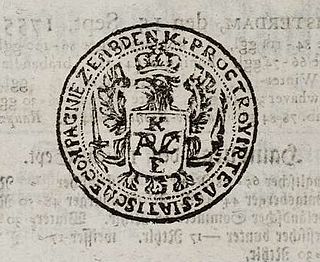
A thaler or taler is one of the large silver coins minted in the states and territories of the Holy Roman Empire and the Habsburg monarchy during the Early Modern period. A thaler size silver coin has a diameter of about 40 mm and a weight of about 25 to 30 grams. The word is shortened from Joachimsthaler, the original thaler coin minted in Joachimsthal, Bohemia, from 1520.

The Maria Theresa thaler (MTT) is a silver bullion coin and a type of Conventionsthaler that has been used in world trade continuously since it was first minted in 1741. It is named after Maria Theresa who ruled Austria, Hungary, Croatia and Bohemia from 1740 to 1780 and is depicted on the coin.

Richard H. Thaler is an American economist and the Charles R. Walgreen Distinguished Service Professor of Behavioral Science and Economics at the University of Chicago Booth School of Business. In 2015, Thaler was president of the American Economic Association.

The tolar or Jáchymovský tolar was a silver coin minted in the Kingdom of Bohemia from 1520 until 1672 in Jáchymov. The obverse of the coin depicts Saint Joachim with the coat-of-arms of the noble family Schlik, who founded the mint in the Ore Mountains, with the titles of the Schlik brothers in inscription: "STEPHANI:ET:FRATRVM: COMITVM:DE:BASSANO". The reverse side depicts the crowned Bohemian lion with the title of the Bohemian King Louis of the Jagiellonian dynasty: "LVDOVICVS DEI GRACIA REX BOHEMIAE".
The Thaler (German) or taler (Polish) was the currency of Danzig (Gdańsk) until 1772 and again from 1807 to 1814. It was subdivided into 4 Gulden, each of 30 Groschen or 90 Schilling (solidus). In both 1772 and 1814, the currency was replaced by the Prussian Thaler.
The Prussian Thaler was the currency of Prussia until 1857. In 1750, Johann Philipp Graumann implemented the Graumannscher Fuß with 14 thalers issued to a Cologne Mark of fine silver, or 16.704 g per thaler.
The North German thaler was the currency of the Electorate and Kingdom of Saxony until 1857. Between 1754 and 1841, it was equal to three quarters of a Conventionsthaler and was subdivided into 24 Groschen, each of 12 Pfennig. In 1841, Saxony partially decimalized, dividing the Thaler into 30 Neugroschen, each of 10 Pfennig. The Thaler was replaced by the Vereinsthaler at par.
The Thaler was the currency of the Electorate, later Kingdom of Hanover until 1857. It was identical to the North German thaler except from 1754 to 1834 when it was worth 1/12 a Cologne Mark of fine silver. It was subdivided into 36 Mariengroschen, each of 8 Pfennig.
The Thaler was the currency of the two Duchies, later Grand Duchies, of Mecklenburg-Schwerin and Mecklenburg-Strelitz until 1857. It was replaced the Mecklenburg Vereinsthaler at par. From the 1750s it was identical to the Hanoverian thaler at 1/12 a Cologne Mark of fine silver. From 1848, it was equal to the Prussian Thaler at 1/14 a Mark.
The North German thaler was the currency of the Landgravate, then Electorate of Hesse-Kassel until 1858. Until 1807, the Thaler was subdivided into 32 Albus, each of 12 Heller. It was worth 3⁄4th a Conventionsthaler from 1754 to 1841.
The Thaler was a coin issued by Baden of varying equivalents to its currency, the South German gulden, each of 60 kreuzer. Beginning in 1690, the Reichsthaler specie coin of 25.984 g fine silver was issued for 2 gulden. After 1754, the Conventionsthaler of 23.3856 g fine silver was issued for 2.4 gulden. Starting in the 19th, century the Kronenthaler of 25.71 g fine silver was issued for 2.7 gulden ; the French silver écu also started being accepted for 2.8 gulden. After 1837, the doppelthaler, which was worth two Prussian thalers, was issued for 31⁄2 gulden. From 1857 to 1871, the Vereinsthaler was issued for 13⁄4 gulden.
The Geneva thaler was a coin equivalent to the French silver écu, containing 26.67 g fine silver and valued at 123⁄4florins, which was issued by Geneva until 1798 and between 1813 and 1839.
Josef Thaler is an Austrian luger who competed in the 1950s. He won two medals at the inaugural event at the FIL World Luge Championships in Oslo in 1955 with a gold in the men's doubles and a silver in the men's singles events.
Erwin Thaler was an Austrian bobsledder who competed in the 1960s. He won two silver medals in the four-man event at the 1964 and 1968 Winter Olympics.

The Floridsdorfer Athletics Sports Club or simply Floridsdorfer AC or FAC is a professional football club based in Floridsdorf, the 21st district of Vienna. The club was founded in August 1904. Floridsdorfer AC won the Austrian football championship in 1918 and are currently playing in the Austrian 2. Liga, the second tier of Austrian football. The club colours are blue and white.

Benjamin Drew Thaler is a professional rugby league referee and one of the Rugby Football League's Full Time Match Officials. He officiates in the Men's Super League.

The Emden Company was a Prussian trading company which was established on 24 May 1751 to trade primarily with the city of Canton in China. Its full name was the Royal Prussian Asiatic Company in Emden to Canton and China, but it was generally known by the shorter name.
Perutherium is monospecific genus of notoungulates from the Late Paleocene to Early Eocene Muñani Formation of Peru. The holotype consists of a fragment of a lower jaw with the posterior half of the first molar and the anterior half of the second molar. A fragment of an upper molar from the same location may also belong to Perutherium.
Events from the year 1534 in Sweden
Barbara Thaler is an Austrian politician of the Tyrolean People's Party (TVP) who was elected as a Member of the European Parliament in 2019.







